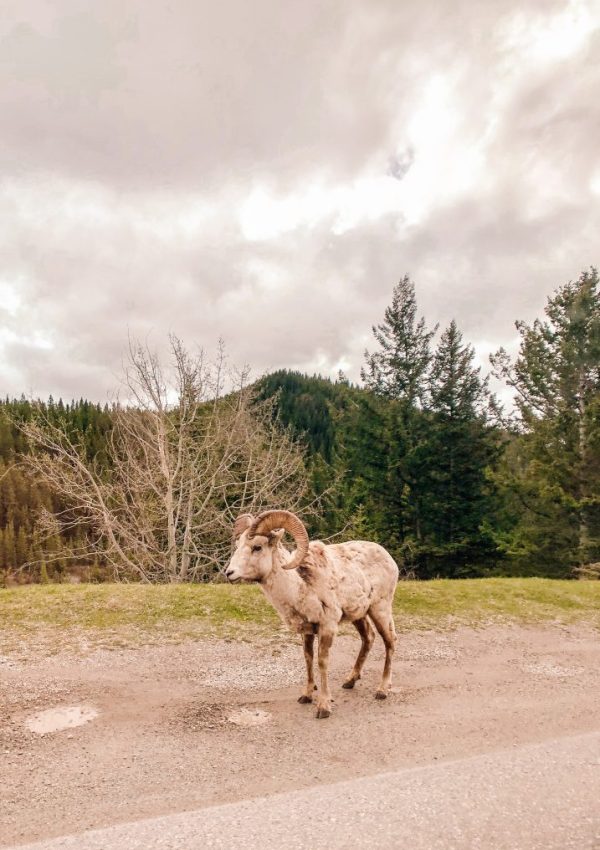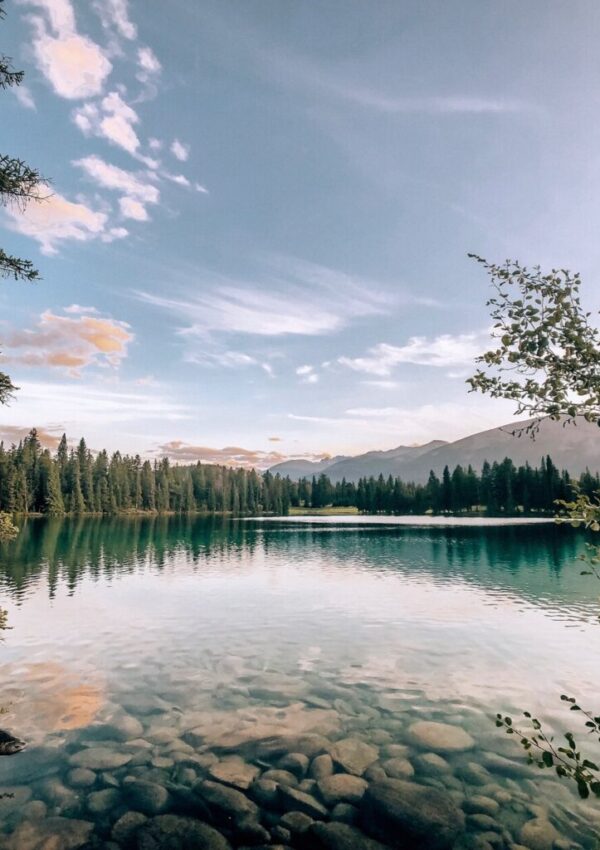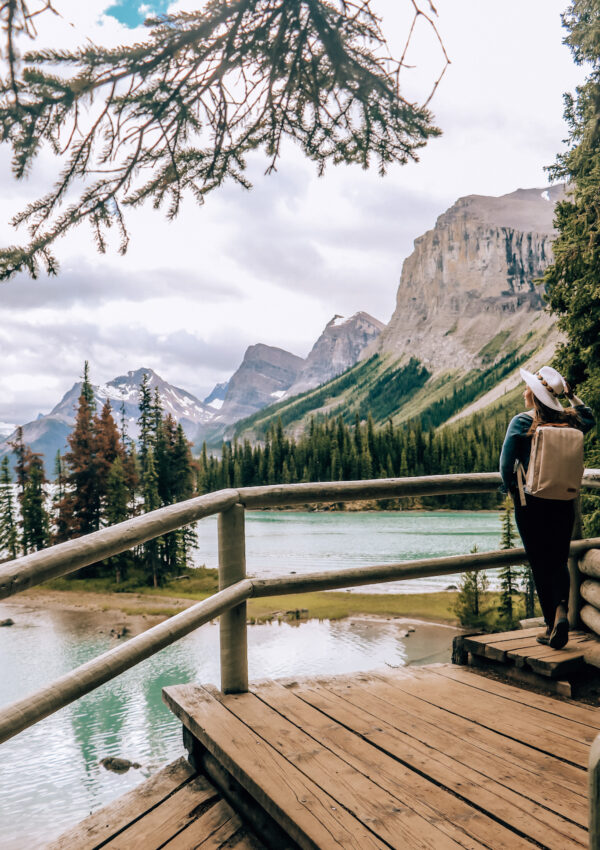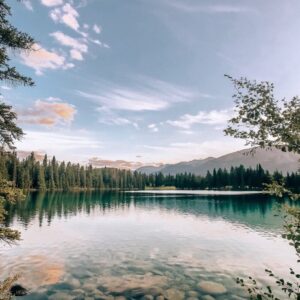Are you getting ready to embark on an unforgettable road trip from Banff National Park to Jasper National Park? I grew up in Alberta and lived in the Rockies, and am STILL blown away by the turquoise lakes, towering peaks, and the wonders of nature at every turn. When you check this Banff to Jasper Itinerary experience off your bucket list and travel this scenic route with awe-inspiring vistas and literal breathtaking landscapes, you’ll discover the spectacular beauty of the Canadian Rockies.
Follow my epic travel guide with this Banff and Jasper itinerary, and get ready to immerse yourself in the unparalleled beauty of Banff and Jasper National Parks. I hope you’re ready for an extraordinary adventure!

Banff to Jasper Road Trip Questions
Before we get to the Banff and Jasper itinerary, I want to answer some of the most asked Banff to Jasper Road Trip Questions.
How long does it take to drive from Banff to Jasper?
When you drive from Banff National Park to Jasper National Park, you’ll cover a distance of about 288 kilometers (179 miles). This is along the Trans-Canada Highway (Highway 1) and Icefields Parkway (Highway 93). The duration of your drive can vary depending on a lot of factors traffic, road conditions, wildlife traffic jams (yes, that’s a real thing), and the number of stops you make along the way.
On average, it takes about 3 to 4 hours to drive from Banff to Jasper. However, many people choose to extend their trip to fully immerse themselves in the breathtaking landscapes. You may want to make frequent stops at the various attractions and viewpoints along the way. I highly recommend you give yourself extra time so that you can fully appreciate the stunning scenery and explore the remarkable sights, transforming your drive into an unforgettable adventure. You won’t regret it!
Looking for a rental car? I’ve got you covered with these rental car options for your road trip.

What is the most scenic route from Banff to Jasper?
The journey from Banff to Jasper is along the iconic Icefields Parkway, also known as Highway 93. It is widely regarded as one of the most breathtaking drives in the world.
What is the best time of year to visit Banff and Jasper?
The best time of year to visit Banff and Jasper National Parks really depends on your preferences and the type of experience you’re seeking. Here’s a breakdown of the different seasons:
- Summer (June to August): This is the peak tourist season when the weather is generally pleasant, with temperatures ranging from 15°C to 25°C (59°F to 77°F) in Banff and slightly cooler in Jasper. The summer months offer the advantage of longer daylight hours, allowing you to maximize your outdoor activities such as hiking, wildlife viewing, and exploring the national parks’ iconic attractions well into the evening. However, be prepared for larger crowds, more traffic, and higher accommodation prices during this time.
- Fall (September to October): Fall in Banff and Jasper is characterized by stunning foliage as the forests transform into a brilliant palette of golden hues. The weather remains mild, with temperatures ranging from 5°C to 15°C (41°F to 59°F). This season offers fewer crowds compared to summer, making it a great time to enjoy the beautiful landscapes, hike on scenic trails, and potentially witness wildlife during their fall migrations. This is one of my favourite times to visit because there are fewer crowds however the lakes haven’t frozen, so you still get more of that “summer” experience.
- Winter (November to March): If you’re a fan of winter activities, like skiing, snowboarding, snowshoeing, and ice skating, then visiting Banff and Jasper during the winter season is ideal. The parks are transformed into a winter wonderland, with snow-covered peaks and frozen lakes. Temperatures can drop below freezing, ranging from -10°C to -20°C (14°F to -4°F). Be prepared for shorter daylight hours, but you’ll have a chance to witness the stunning beauty of the parks in a peaceful and serene setting. Here are 3 Reasons to visit Banff in Winter.
- Spring (April to May): Spring in Banff and Jasper is a transitional period, where you can witness the parks coming alive with vibrant wildflowers and the return of wildlife. The temperatures gradually start to warm up, ranging from 5°C to 15°C (41°F to 59°F), but snow and chilly weather can still be present, especially during early spring. It’s a quieter time to visit compared to summer, with opportunities for hiking, wildlife spotting, and enjoying the emerging beauty of nature.
For the purpose of this Canadian Rockies road trip travel guide, I’m going to base the recommendations I make in my Banff and Jasper itinerary on the Summer and Fall season.

Your Ultimate Banff to Jasper Road Trip Itinerary
A road trip from Banff to Jasper offers breathtaking views of the Canadian Rockies and stunning natural landscapes. Here’s a detailed itinerary for your journey, including the main route, distances, estimated driving times, and some alternative routes you can consider:
Banff to Jasper Itinerary Day 1:
- Start your road trip in Banff, Alberta.
- Drive from Banff to Lake Louise (58 km / 36 mi, approximately 45 minutes).
- Spend some time exploring Lake Louise and its famous turquoise waters. Consider hiking around the lake or visiting the Fairmont Chateau Lake Louise. (*Note: during the busy summer season, many parts of the Fairmont are only accessible for hotel guests.)
- Drive from Lake Louise to the Columbia Icefield (125 km / 78 mi, approximately 1.5 hours).
- Take a guided tour onto the Athabasca Glacier or visit the Glacier Skywalk for panoramic views. Try this Full Day Icefields Parkway Tour which includes both.
- Continue driving from the Columbia Icefield to the town of Jasper (103 km / 64 mi, approximately 1.5 hours).
- Arrive in Jasper and settle into your accommodation.

Banff to Jasper Itinerary Day 2:
- Explore Jasper National Park.
- Visit Maligne Lake (50 km / 31 mi, approximately 1 hour) and consider taking a boat tour to Spirit Island. This Wildlife and Waterfalls Tour with Maligne Lake Cruise to Spirit Island is incredible!
- Drive to Maligne Canyon (10 km / 6 mi, approximately 15 minute drive) and do an easy hike along the scenic canyon trails.
- Head back to Jasper and spend the evening in the town, enjoying its charming atmosphere and local restaurants.

Banff to Jasper Itinerary Day 3:
- Take a day trip to Mount Edith Cavell (45 km / 28 mi, approximately 1 hour) for stunning views of Angel Glacier.
- Hike the Path of the Glacier Trail for a closer look at the glacier and surrounding peaks (approximately 1 hour).
- Return to Jasper and explore some of the local shops and galleries or continue to Sunwapta Falls (56 km, approximately 1 hour).
- Take a short walk to view the impressive waterfalls and enjoy the natural beauty of the area. If time allows, try a River Rafting Trip on Sunwapta River.
- Return to Jasper (56 km / 34 mi, approximately 43 minutes)
Banff to Jasper Itinerary Day 4:
- Depart from Jasper and start your return journey. You may want to give yourself 1-3 more days for your return trip based on your route. *Various route options are available below.

Alternative Banff to Jasper Itinerary Return Routes:
- Icefields Parkway Loop:
- From Jasper, drive south on the Icefields Parkway (Highway 93) to Lake Louise.
- Continue on Highway 1 (Trans-Canada Highway) to Yoho National Park and visit attractions like Emerald Lake and Takakkaw Falls. If time allows, I recommend you do the Full-Day Yoho National Park and Grizzly Bear Refuge Tour.
- Return to Banff via Highway 1, completing a loop. This route adds additional driving time but offers diverse scenery and more attractions.
- Highway 16 Route:
- From Jasper, drive east on Highway 16 to Hinton.
- Continue on Highway 16 to Edmonton, Alberta’s capital city.
- Explore Edmonton or continue further eastward to Saskatchewan or Manitoba.
Here are some recommendations for the Best Things to Do in Edmonton.
What are some recommended places to eat and stay during the road trip?
During your road trip from Banff to Jasper, you’ll come across various dining and accommodation options that cater to different tastes and budgets. Here are some recommended places to eat and stay along the route.
Best Places to Eat:
- STOCK at Fairmont Banff Springs (Banff): STOCK Food + Drink is a great place to fuel up with coffee, pastries, soups and sandwiches before your road trip. Eat in or grab your goodies to go.
- Storm Mountain Lodge (near Castle Junction): Stop by this charming lodge’s restaurant for a unique dining experience. Enjoy delicious dishes made from scratch, using fresh ingredients and flavors inspired by the Canadian Rockies.
- Columbia Icefield Glacier View Restaurant (Icefields Parkway): Situated at the Columbia Icefield Visitor Centre, this restaurant offers panoramic views of the surrounding glaciers. Grab a bite while enjoying the breathtaking scenery.
- Sunwapta Falls Rocky Mountain Lodge (near Sunwapta Falls): This lodge features a restaurant that serves hearty meals with a focus on regional flavors. It’s a great place to relax and refuel after exploring the nearby waterfalls.
Looking for the Best Restaurants to Dine in Jasper? Look no further!

Places to Stay:
- Fairmont Banff Springs (Banff): This castle-like hotel offers a luxurious stay with stunning views of the surrounding mountains. Experience the grandeur of the Rocky Mountains while enjoying top-notch amenities and services.
- Fairmont Chateau Lake Louise (Lake Louise): A renowned luxury hotel overlooking the iconic Lake Louise, the Fairmont offers elegant accommodations, world-class dining, and a range of outdoor activities for a truly unforgettable experience.
- HI-Rampart Creek Wilderness Hostel (Icefields Parkway): For budget-conscious travelers, this wilderness hostel provides a unique experience. It’s a rustic and off-the-grid accommodation option with shared facilities, perfect for those seeking a closer connection with nature.

I’ve got an entire post dedicated to Where to Stay in Jasper, Alberta. Check it out!
Remember to book accommodations in advance, especially during peak travel seasons, as they can fill up quickly. Additionally, explore other lodging and dining options along the route to find establishments that suit your preferences and budget.

Banff and Jasper Itinerary: Highlights and Must-See Attractions
Here are some iconic and must-visit attractions on the Banff to Jasper route, along with information about each location, its natural features, activities, and popular outdoor adventures:
Johnston Canyon:
- Johnston Canyon is known for its stunning waterfalls, crystal-clear streams, and scenic canyon views.
- The Johnston Canyon trail is relatively accessible, making it suitable for a wide range of visitors. The trail is well-maintained, with a mostly paved path and sturdy catwalks and bridges that provide safe passage through the canyon. This accessibility makes it a popular choice for families, casual hikers, and those looking for a shorter, less strenuous hike.
- The highlight of Johnston Canyon is the opportunity to see two beautiful waterfalls: the Lower Falls and the Upper Falls. The Lower Falls are easily accessible from the trailhead, requiring just a short walk. The Upper Falls are located further along the trail and involve a moderate uphill hike. Both waterfalls are impressive and offer great photo opportunities.

Lake Louise:
- Lake Louise is known for its stunning turquoise-colored waters, surrounded by towering mountain peaks.
- It offers scenic beauty and opportunities for photography, leisurely walks along the lakeshore, and relaxation in a serene setting.
- Visitors can hike around the lake, rent canoes to explore the waters, or enjoy a meal at the historic Fairmont Chateau Lake Louise.
- Popular hikes in the area include the Lake Agnes Tea House hike, Plain of Six Glaciers hike, and Big Beehive hike, offering varying levels of difficulty and panoramic views.
Moraine Lake
- Moraine Lake is renowned for its stunning turquoise-blue waters surrounded by towering snow-capped mountains and dense forests. The vibrant color of the lake, caused by rock flour suspended in the water, creates a mesmerizing visual spectacle that is truly awe-inspiring.
- The Valley of the Ten Peaks serves as a majestic backdrop to Moraine Lake, adding to its allure. The ten towering peaks provide a dramatic and picturesque scene, making it one of the most photographed locations in the Canadian Rockies.
- The area around Moraine Lake offers several hiking trails for different skill levels. The Rockpile Trail is a short hike, an easy 5 minute walk really, that provides a panoramic view of the lake and the Valley of the Ten Peaks. For more adventurous hikers, trails like the Larch Valley/Sentinel Pass or Eiffel Lake offer a chance to explore the surrounding alpine landscapes.
- Please note, as of 2023 personal vehicles do NOT have access to Moraine Lake. You must take the Park & Ride Shuttle or ROAM public transit. Neither of these options are available for sunrise. If you wish to visit Moraine Lake at sunrise, this private tour of Moraine Lake at Sunrise is a great option.

If you wish to do a day trip from Banff to visit Lake Louise and Moraine Lake, I highly recommend this Lake Louise and Moraine Lake Private Tour. You will be picked up from your Banff hotel and as its a return trip, you won’t need to worry about finding parking at these iconic landmarks.
Icefields Parkway:
- The Icefields Parkway (Highway 93) is a renowned scenic highway that stretches from Lake Louise to Jasper, offering breathtaking views of glaciers, waterfalls, and rugged mountain landscapes.
- It is considered one of the most scenic drives in the world.
- Along the way, you’ll encounter viewpoints like Bow Lake, Peyto Lake, and Mistaya Canyon, which provide excellent photo opportunities and short walks to admire the natural beauty.
- Wildlife sightings are common, so keep an eye out for animals such as bears, elk, and mountain goats.

Athabasca Glacier and Columbia Icefield:
- The Athabasca Glacier is a part of the Columbia Icefield, one of the largest icefields in North America.
- Visitors can take guided tours onto the glacier to explore its unique landscape of ice formations and learn about glaciology.
- The Glacier Skywalk is another attraction in the area, offering a glass-floored observation platform with stunning views of the surrounding mountains and valleys.
Maligne Lake:
- Maligne Lake is known for its crystal-clear waters and picturesque setting within Jasper National Park.
- Boat tours to Spirit Island are a popular activity, providing access to one of the most photographed locations in the Canadian Rockies.
- Hiking trails around Maligne Lake offer opportunities for exploration, such as the Maligne Lake Lakeshore Trail and Bald Hills Trail.
- Wildlife viewing is also common in the area, with chances to spot moose, bears, and various bird species.

Outdoor Activities:
- Hiking: There are numerous hiking trails available throughout the Banff to Jasper route, ranging from easy walks to challenging mountain hikes. Make sure to check trail conditions, bring appropriate gear, and be prepared for changing weather conditions.
- Biking: Cycling is a popular activity along the Icefields Parkway, with designated bike lanes and stunning scenery. Bicycles can be rented in Banff or Jasper.
- Wildlife Watching: The Canadian Rockies are home to diverse wildlife. Keep a safe distance and be respectful of the animals. Wildlife can often be spotted along the roadside or during hikes.
- Canoeing and Kayaking: Lake Louise, Maligne Lake, and other nearby lakes offer opportunities for canoeing and kayaking. Rentals are available at these locations.
- Photography: The entire route provides exceptional opportunities for photography. Capture the beauty of the landscapes, lakes, glaciers, and wildlife. Be prepared with the right equipment and take advantage of golden hour lighting for stunning shots. However do be aware that you are not allowed to use drones in Canada’s national parks.
It’s important to check park regulations, obtain any required permits, and be prepared for outdoor activities by carrying essential gear, water, and snacks. Stay informed about wildlife safety guidelines and practice Leave No Trace principles to preserve the natural beauty of these areas.

More Questions about Banff and Jasper, Answered
Is it worth driving to Jasper from Banff?
YES! When they said ‘life is about the journey, not the destination’ I’m certain they were talking about driving from Banff to Jasper. It is a once-in-a-lifetime experience that should not be missed. Here are a few reasons why driving the Icefields Parkway from Banff to Jasper is worth it:
- Stunning Natural Landscapes
The route between Banff and Jasper is a visual feast for nature lovers. You’ll be treated to majestic mountain peaks, pristine turquoise lakes, cascading waterfalls, and vast glaciers. The panoramic vistas along the Icefields Parkway are simply awe-inspiring, offering endless photo opportunities and moments of pure wonder. - Wildlife Encounters
The Canadian Rockies are home to a diverse array of wildlife, and driving along this route increases your chances of spotting them. Keep your eyes peeled for elk, deer, bighorn sheep, mountain goats, and even the elusive black bears or grizzly bears. Just remember to observe them from a safe distance and respect their natural habitat. - Must-see Attractions and Viewpoints
Along the way, you’ll encounter several must-visit attractions that are unique to this region. Stops such as beautiful Lake Louise, Moraine Lake, Peyto Lake, Athabasca Glacier, and Maligne Lake offer unforgettable experiences and showcase the natural beauty that has made the Canadian Rockies famous worldwide. - Scenic Viewpoints and Hiking Trails
The Icefields Parkway is dotted with numerous scenic viewpoints and hiking trails. These stops allow you to immerse yourself in the pristine wilderness, breathe in the fresh mountain air, and appreciate the grandeur of the surrounding landscapes up close. From short walks to longer hikes, there are options available for all fitness levels and time limitations. - Flexibility and Freedom
Driving from Banff to Jasper gives you the freedom to set your own pace and explore the route at your leisure. You can stop whenever you want to take photos, stretch your legs, or simply soak in the beauty of the surroundings. It allows you to fully appreciate the journey and create your own unforgettable memories.

What is the best parking lot at Lake Louise?
The best parking lot at Lake Louise depends on what you plan to do and the time of year you’re visiting. Here are a few options:
- Park & Ride: If you prefer to avoid the congestion near the lake, you can park at the Park & Ride area across the Trans Canada Highway from the Lake Louise Village. This lot has free parking. From there, you can take the shuttle bus to the both Lake Louise and Moraine Lake. The shuttle operates throughout the day. This option allows you to avoid the stress of finding parking and provides flexibility for your visit. Read more for further details about Park & Ride parking and reservations.
- Lake Louise Lakeshore Parking Lot: I do not recommend this parking option during high season (June to September). While this parking lot is closest to the lake itself and is the most convenient if you want to take a leisurely stroll along the lakeshore or enjoy the iconic views of Lake Louise, it fills up quickly (by 7 am) during peak tourist season.
Keep in mind that during high season, parking at Lake Louise can be challenging, and the lots can fill up quickly. It’s best to arrive early in the day or consider visiting during less busy times, such as October to May, to increase your chances of finding parking.
Are there any fees or permits required for visiting the national parks?
When visiting Banff and Jasper National Parks, you will need to pay an entrance fee, which grants you access to the parks. The fees vary depending on the season and are charged per vehicle. Additionally, if you plan to visit multiple national parks and sites in Canada within a year, purchasing a Discovery Pass can offer cost savings.
For specific activities, such as backcountry camping, fishing, or guided tours, additional permits or licenses may be required. Backcountry camping permits are necessary if you plan to camp in the backcountry, and fishing licenses are required for anglers. Guided tours and activities may have separate fees and reservations, so it’s best to check with authorized operators or visit the Parks Canada website for detailed information.

Is it better to drive from Banff to Jasper or Jasper to Banff?
Driving from Banff to Jasper or from Jasper to Banff both offer unforgettable road trip experiences through the stunning Canadian Rockies. Choosing the direction depends on personal preference, timing, and itinerary. And of course which airports you are arriving into and flying out of. Driving from Banff to Jasper allows for a gradual build-up of awe-inspiring scenery, passing through attractions like Lake Louise and the Columbia Icefield. On the other hand, driving from Jasper to Banff creates anticipation as you approach the grandeur of Banff National Park and offers breathtaking views along the Icefields Parkway. Consider a circular route if possible to enjoy the best of both directions. Whichever way you choose, prepare for incredible natural beauty, wildlife sightings, and a memorable journey through the Rockies.
How many days do you need to see Banff and Jasper?
To fully experience the highlights of Banff and Jasper, I recommend a minimum of 5 to 7 days. Spend 2 to 3 days in Banff National Park, exploring attractions like Lake Louise and Johnston Canyon, and engaging in outdoor activities. Allocate a full day for the scenic drive along the Icefields Parkway, making stops at Peyto Lake and the Columbia Icefield. Reserve another 2 to 3 days in Jasper National Park to visit Maligne Lake and Athabasca Falls, and enjoy hiking and wildlife viewing. If you have more time, extend your stay to delve deeper into the natural wonders and take advantage of additional outdoor activities.

What is the weather like in Banff and Jasper?
The weather in Banff and Jasper National Parks varies depending on the season and elevation. Summers are mild to warm, with temperatures ranging from 15°C to 25°C (59°F to 77°F) in lower elevations. Fall brings cooler temperatures and changing foliage colors, while winters are cold with temperatures often below freezing, making it ideal for winter sports. Spring has milder temperatures, but it can still be chilly, with rapidly changing weather patterns. It’s important to check the local forecast and dress in layers to accommodate the variable conditions that can occur in the mountainous regions.
What are the safety tips and precautions for the road trip?
When embarking on a road trip through Banff and Jasper, it’s essential to prioritize safety. Here are some safety tips and precautions to consider:
- Plan and Prepare
Before your trip, plan your itinerary, research road conditions, and check for any closures or advisories. Ensure your vehicle is in good working condition, including checking tires, brakes, and fluids. Pack emergency supplies, including a first aid kit, extra food and water, warm clothing, a flashlight, and a roadside emergency kit. - Follow Traffic Rules and Speed Limits
Observe and obey all traffic rules and regulations, including speed limits. Be aware of wildlife crossing areas and reduce your speed accordingly. Keep a safe distance from other vehicles and use turnouts when necessary to allow faster traffic to pass. - Wildlife Safety
Wildlife, such as elk, deer, and bears, are commonly seen in Banff and Jasper National Parks. Admire them from a safe distance and never feed or approach them. Be cautious when driving at dawn or dusk when animals are more active and may be crossing roads. Use wildlife underpasses or overpasses where available. - Stay on Designated Roads and Trails
Stick to designated roads and trails and avoid venturing into restricted or closed areas. Off-road driving is strictly prohibited and can cause irreparable damage to the environment. - Weather Awareness
Mountain weather can change rapidly, so stay informed about weather conditions and be prepared for sudden changes. Check weather forecasts, road conditions, and avalanche bulletins if traveling during winter. Adjust your plans if necessary for safety. - Rest and Fatigue Management
Take regular breaks during long drives to combat driver fatigue. Fatigue can impair reaction times and increase the risk of accidents. If feeling tired, find a safe place to pull over, rest, and rejuvenate before continuing. - Cell Phone Coverage
Be aware that cell phone coverage may be limited in certain areas, especially in remote parts of the parks. Inform someone of your travel plans and check-in with them regularly. - Leave No Trace
Respect and preserve the natural environment by practicing Leave No Trace principles. Pack out all garbage, dispose of waste properly, and avoid littering. Respect wildlife and their habitats.
Remember, safety is paramount, so exercise caution, use common sense, and be prepared for unexpected situations. Stay alert, enjoy the breathtaking scenery, and have a memorable and safe road trip through Banff and Jasper.
Banff to Jasper Itinerary
This post may contain affiliate links. This means that at no extra cost to you, I earn a small commission if you make a purchase. Thank you for your support!






Leave a Reply